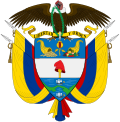| This article is part of a series on the |
| Politics of Colombia |
|---|
 |
Presidential elections were held in Colombia in February 1922. [1] The result was a victory for Pedro Nel Ospina of the Conservative Party, who received 62% of the vote. [2] He took office on 7 August. [3]
His main opponent, Benjamín Herrera of the Liberal Party, was also supported by the Socialist Party. [2] The Liberal Party claimed that the election had been marred by blatant fraud. [2]